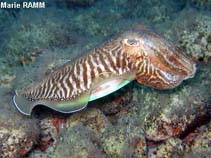Sepia officinalis Linnaeus, 1758
Common cuttlefish| Native range | All suitable habitat | Point map | Year 2050 |

|
| This map was computer-generated and has not yet been reviewed. |
| Sepia officinalis AquaMaps Data sources: GBIF OBIS |
Classification / Names Common names | Synonyms | CoL | ITIS | WoRMS
Cephalopoda | Sepiida | Sepiidae
Environment: milieu / climate zone / depth range / distribution range Ecology
Benthic; depth range 0 - 242 m (Ref. 1695), usually 0 - 50 m (Ref. 88010). Tropical, preferred 21°C (Ref. 107945); 62°N - 4°N, 32°W - 37°E (Ref. 1695)
Distribution Countries | FAO areas | Ecosystems | Occurrences | Introductions
Eastern Atlantic and the Mediterranean: from the Shetlands and southern Norway (stray in the Baltic Sea), south to the Mediterranean Sea to northwestern Africa.
Length at first maturity / Size / Weight / Age
Maturity: Lm ?, range 9 - ? cm Max length : 49.0 cm ML male/unsexed; (Ref. 1695); max. published weight: 4.0 kg (Ref. 1695)
In temperate waters, maximum mantle length is 49 cm and up to 4 kg in weight. In the subtropics, maximum mantle length is 30 cm and up to 2 kg in weight (Ref. 1695). Common size: 15.0 to 25.0 cm (West Saharan fisheries; Ref. 275). One of the most important species for cephalopod fisheries in many countries but have been observed in recent years that it is heavily fished, e.g., Mediterranean (Ref. 1695). Also, a highly valued item especially in Japan, Korea, Italy and Spain (Ref. 1695). Maximum depth range from Ref. 114857. A neritic, demersal species found in the subtidal zone to depths of 200 m, generally over sandy-muddy substrates (Ref. 1695, page 100). Presence in Portuguese waters indicates its tolerance for brackish water. Undergoes seasonal migrations between inshore waters in spring and summer and medium shelf grounds (around 100 m depth) in autumn and winter. Courtship behavior is elaborate and ritualized with visual displays and 'mate guarding'. Spawns in shallow waters, optimally between 13° to 15°C. Eggs, 8 to 10, mm diameter and blackened with ink, are attached on seaweed, shells, debris and other substrates, in grape-like clusters. Depending on water temperature, eggs hatch after 30 to 90 days. Hatchlings measure about 7 to 8 mm TL. From hatchlings to adults, exhibit light-induced burying behavior where most individuals hide in sand during the day and where prey is often ambushed. Life cycle under natural conditions, between 12 to 24 months. Feeds on small mollusks, crabs, shrimps, other cuttlefishes, and juvenile demersal fishes. Cannibalism is common. Considered one of the most commercially important cephalopod species. With potential for aquaculture. Usually marketed fresh or frozen as a highly valued food item, especially in Japan, Korea, Italy and Spain (Ref. 1695).
Life cycle and mating behavior Maturity | Reproduction | Spawning | Eggs | Fecundity | Larvae
Male and female adults usually die shortly after spawning and brooding, respectively. Mating behavior: Males perform various displays to attract potential females for copulation. During copulation, male grasp the female and inserts the hectocotylus into the female's mantle cavity where fertilization usually occurs. Life cycle: Embryos hatch into planktonic stage and live for some time before they grow larger and take up a benthic existence as adults (Ref. 833).
Main reference
References | Coordinator | Collaborators
Schneider, W. 1990. (Ref. 417)
IUCN Red List Status
(Ref. 130435: Version 2024-2)
Least Concern (LC) ; Date assessed: 15 March 2009
CITES status (Ref. 108899)
Not Evaluated
CMS (Ref. 116361)
Not Evaluated
Threat to humans
Human uses
Fisheries: commercial
FAO - Aquaculture: production; Fisheries: landings, species profile | FIRMS (Stock assessments) | FishSource | Sea Around Us
Tools
More information
Trophic Ecology
Ecology
Population dynamics
Growth
Max. ages / sizes
Length-weight rel.
Length-length rel.
Length-frequencies
Mass conversion
Recruitment
Abundance
Max. ages / sizes
Length-weight rel.
Length-length rel.
Length-frequencies
Mass conversion
Recruitment
Abundance
Life cycle
Distribution
Human Related
Aquaculture profiles
Stamps, coins, misc.
Stamps, coins, misc.
Outreach
Taxonomy
References
Internet sources
BHL | BOLD Systems | CISTI | DiscoverLife | FAO(Fisheries: species profile; publication : search) | Fishipedia | GenBank (genome, nucleotide) | GloBI | Gomexsi | Google Books | Google Scholar | Google | PubMed | Tree of Life | Wikipedia (Go, Search) | Zoological Record
Estimates based on models
Preferred temperature
(Ref. 115969): 8.4 - 19.7, mean 11.3 (based on 1048 cells).
Resilience
(Ref. 69278):
High, minimum population doubling time less than 15 months (K=0.58-0.63; tm=1).
Prior r = 0.50, 95% CL = 0.33 - 0.76, Based on 3 full stock assessments.
Nutrients : Calcium = 126 [75, 177] mg/100g; Iron = 4.79 [1.67, 7.92] mg/100g; Protein = 15.5 [13.7, 17.4] %; Omega3 = 0.414 [0.262, 0.566] g/100g; Selenium = 57.8 [48.5, 67.2] μg/100g; VitaminA = 0 μg/100g; Zinc = 1.97 [0.92, 3.02] mg/100g (wet weight); based on nutrient studies.



